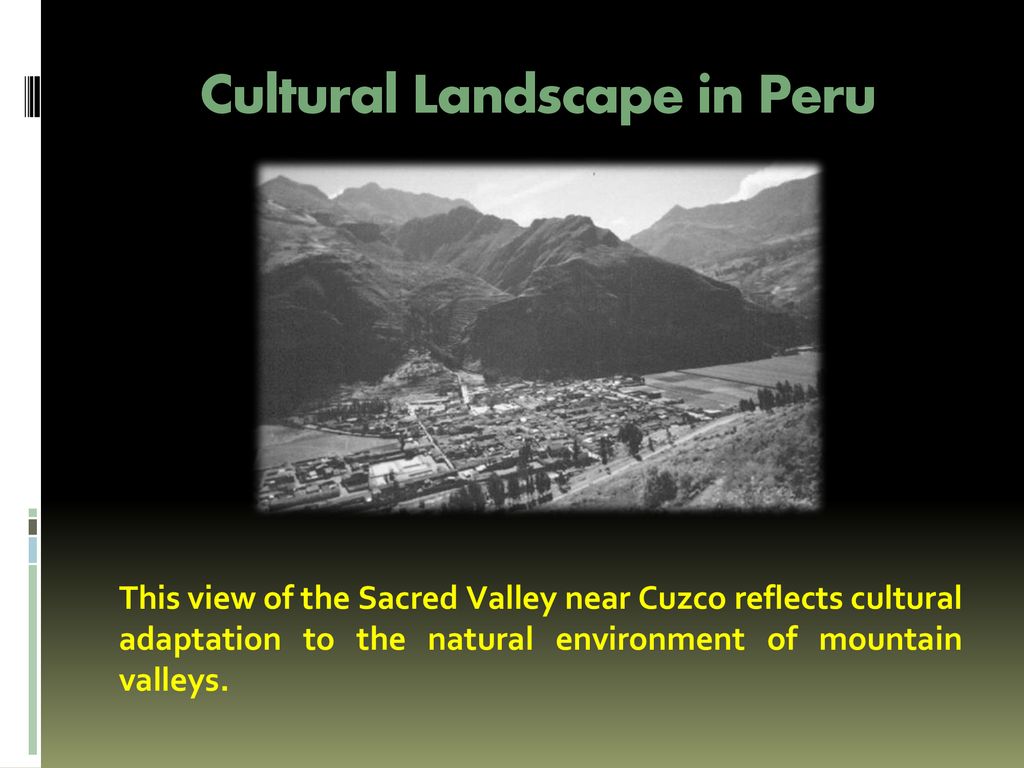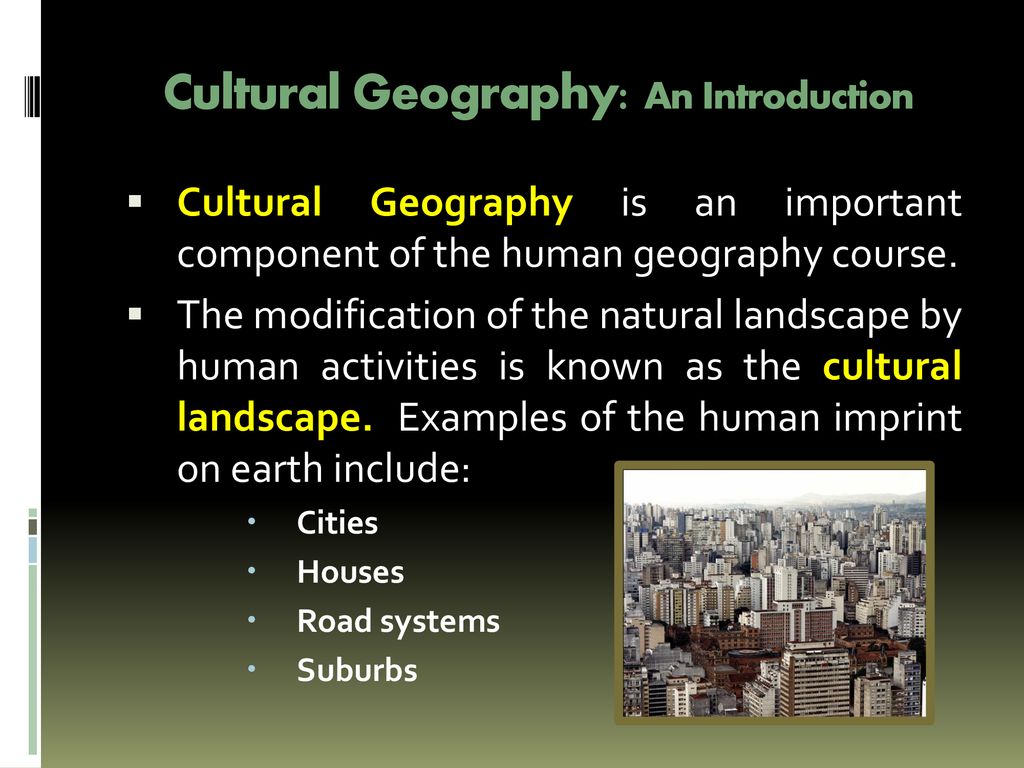Students employ spatial concepts and landscape analysis to examine socioeconomic organization and its environmental This se. An associative cultural landscape which may be valued because of the religious artistic or cultural associations of the natural element.

Ap Human Geography Political Geography Chapter 8 Key Issue 4 Youtube
Notion that successful societies leave their cultural imprints on a place each contributing to the cumulative cultural landscape.

. The visible imprint of human activity on the landscape. February 8 2022 What best describes an unsubsidized federal loan QA February 8 2022 Why is it important to consider the historical context surrounding an event QA February 8 2022 Who is the 1 president of Mexico QA February 8 2022 How often does a transmission need to be replaced QA February 8 2022 Under what circumstances does maintaining a proper. A cultural landscape is defined as a geographic areaincluding both cultural and natural resources and the wildlife or domestic animals therein associated with a historic event activity or person or exhibiting other cultural or aesthetic values.
Cultural landscape is made up of structures within the physical landscape caused by human imprinthuman activities. Cultural landscapes is another relatively new subject heading. Sauer argued that all regions of the Earth were impacted by human behavior and had been altered by human interaction he also believed that cultural landscapes were the most important branch of geographic inquiry.
If you do a keyword search for cultural geography you get all the rest of the stuff. The challenge is to take advantage of the site and situation of the community in which you teach. This is an important concept in geography because it symbolizes how humans interact with their surroundings.
Cultural Landscape The visible imprint of human activity and culture on the landscape. The layers of buildings forms and artifacts sequentially imprinted on the landscape by the activities of various human occupants. Belief in belonging to a group or central cultural aspect.
Understanding the Cultural Landscape. Fashioning of a natural landscape by a cultural group. There are four non-mutually exclusive types of cultural landscapes.
The AP Human Geography course is equivalent to an introductory college-level course in human geography. Area of Earth distinguished by distinctive combinations of cultural and physical features Formal Uniform Region An area in which everyone shares in one or more distinctive characteristics. Buildings artwork Protestant churches in the US South - Cathedrals in Southernwestern Europe mosques in Southwest Asia.
Good for undergraduate students the book traces the human imprint on the land from early human civilization to the early 21st century. All the knowledge and values shared by a community. Thanks to the internet you can take students on virtual field trips without having to worry about whether they have their passports.
Most of Cultural Geography. While exploring the courses cultural unit. One example is the Berlin Wall which was built in 1961 by Soviet controlled East Germany to contain the portion of the city that had been given over to America England and France to administer.
Cultural appropriation describes a situation where a dominant cultural group takes a product or idea from an oppressedminority cultural group and uses it for its own benefit. There are four general types of cultural landscapes not mutually. 32 Cultural Landscapes Cultural landscapes are combinations of physical features agricultural and industrial practices religious and linguistic characteristics evidence of sequent occupancy and other expressions of culture including traditional and postmodern architecture and.
What Is Cultural Landscape In Human Geography. This is the essence of how humans. Ones belief in belonging to a group or certain cultural aspect.
The notion that successive societies leave their cultural imprints on a place each contributing to the cumulative cultural landscape. The first 30 are the most relevant in the keyword search. A relic boundary is one that no longer functions but can still be detected on the cultural landscape Example.
The National Park Service defines a cultural landscape as a geographic area including both cultural and natural resources and the wildlife or domestic animals therein associated with a historic event activity or person or exhibiting other cultural or aesthetic values. Cultural Landscape a geographic area the includes cultural resources and natural resources associated with the interactions between nature and human behavior Sequent-Occupance. The physical landscape that exists before it is acted upon by human culture.
Distinct traditions beliefs and social life brought or controlled by a dominion of a monarchy of a certain region. As defined by the National Park Service a Cultural Landscape is a geographic area including both cultural and natural resources and the wildlife or domestic animals therein associated with a historic event activity or person or that exhibits other cultural or aesthetic values. Introduction AP Human Geography provides many opportunities for authentic learning using applied concepts.
Using a Native-American tribal name as an American sports. An associative cultural landscape which may be valued because of the religious artistic or cultural associations of the natural element. A geographic area the includes cultural resources and natural resources associated with the interactions between nature and human behavior.
The course introduces students to the systematic study of patterns and processes that have. Cultural landscape is a term used in the fields of geography ecology and heritage studies to describe a symbiosis of human activity and environment. The way humans adapt to the physical and cultural landscape they are living in.
The idea of cultural landscapes is most closely associated with the geographer Carl Sauer who first defined them. The visible imprint of human activity and culture on a landscape. Cultural landscape is a term used in the fields of geography ecology and heritage studies to describe a symbiosis of human activity and environment.
Geographic approach that emphasizes human-environmental relationships. Much emphasis is put on the Asia-Pacific region from this interdisciplinary group of contributors from universities around the world. WHAT IS AP HUMAN GEOGRAPHY.
A group of cultural traits. Cultural attributes of an area often used to describe a place eg buildings theaters places of worship.

Cultural Landscape The An Introduction To Human Geography 2 Downloads 12 Rubenstein James M Amazon Com

Chapter 4 Key Issue 4 Folk Popular Culture Ap Human Geography Youtube

Advanced Placement Human Geography Ppt Download

Advanced Placement Human Geography Ppt Download

Cultural Landscape Folk Housing Ap Human Geography A Mcalister December 1 Ppt Download
Overview Of Human Geography Cultural Landscapes

Introduction To Human Geography What Is Human Geography

Chapter 4 Key Issue 1 Folk Pop Culture Ap Human Geography Youtube
0 comments
Post a Comment